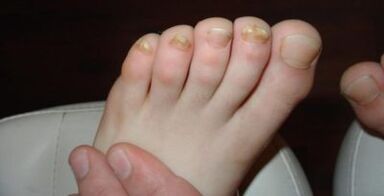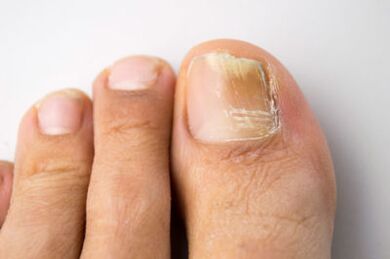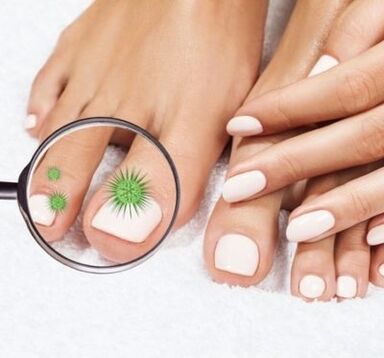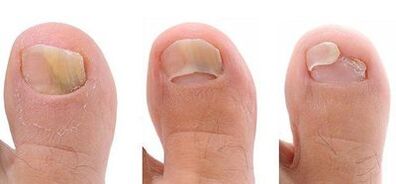Failure mycosis is an infection accompanied by a cosmetic defect and a series of clinical symptoms.Pathological changes are related to the stratum layer of the skin and nail plate.The causal agent of Mycos are representatives of the lower class: fungi.The infectious process is dangerous not only for the patient himself, but also because of the loved ones around him.It will discuss how to prevent nail mycosis and get rid of infection.
Leg nail mycosis: What is it?
Legs on the legs are called onychomycosis and refers to a special classification of diseases.Recently, complaints about infection have grown several times.Doctors associate this indicator with unhealthy ecology.

Onicycosis is a disease in which the structure of the nail plate and the epidermal layer is altered.Surrounding fabrics (leather roller) are involved in the pathological process.The nail is arranged in such a way that the cells are closed closely to each other, forming a dense surface.Under the nail plate, the matrix and blood vessels are placed, which surround the bone phalanx.The upper layer is represented by Hyponichia, and at the base of the nail there is Eponichia.With the mycosis of the nail, the pathogen affects the lower layers of the nail to the matrix.At the same time, dividing cells destroy keratocytes and nail plate is thinned and brittle.Onicycosis, in the absence of treatment, is accompanied by several complications and it is difficult to give in to modern therapy.
They know a little more than 50 types of fungal infections that are dangerous for humans.All of them have several morphological characteristics and parasitic stages.To finally identify the pathogen, a mandatory microscopic examination is carried out.
Leg nails are necessary to protect the soft tissue of the fingers from the lesions.Fashionistas paint nails in different colors, so mycosis is also considered a cosmetic defect.With onychomycosis, the appearance of the nail worsens.Nail plates exploit, completely break and destroy.The disease causes an exacerbation of chronic systemic pathologies.
Having penetrated the nail layer, the causal agent begins to actively share, releasing new and new micelius threads.Due to air deficiency, the mycelium applies to healthy areas of nail and skin.The disease should be diagnosed and treated.
Types of disease
Several types of pathogens are distinguished, which affect the legs in the legs.Classify the parasites according to morphological characteristics and clinical signs.
- Trichophyte is red, a fungus that has a branch and disputes in the mycelium threads.The location of the process falls into the epidermis, gross (keratinized) parts of the cells.A specific characteristic of the red trichophyton damage is the rigma of the fabrics.Light points and stripes are disparate and then merger.In the thickness of the skin cells, the mycelium is compact, stretch and forms disputes that can resist the methods of several treatment.When staining the drug of the nail in a microscope, the trichofiton structure is clearly visible.
- The epidermophyte has a flap shape, a microorganism that causes the mycosis of the nails in the legs in the form of skin peeling, itching to the interback space and the stratification of the nail.Unlike Trichophyton, Epidermophyton grows in several directions of its spore cell, so the location of the process is blurred.Micelium of several thicknesses: from delicate thin to wide and short.When studying a microscopic medicine, spores and part of the mycelium are compared to the flakes.Epidermophyte infection is accompanied by a change in nail pigmentation and gradual destruction.The infectious process begins both from the edge of the nail plate and from its base.In addition to the bitter of the patient's nail plate, the increase in dryness and rapid keratinization are concerned.
- Mentagrofitest is one of Trichophyton's brilliant representatives.It is less common, affects the skin of the feet, nail rollers of the legs and nail plate itself.The causal agent penetrates the lower layers and can reach the submarine - matrix epidermis.It causes a seal of the stratum and thick stratum of delicate parts of the nail.Statistics show that almost 20 % of fungal infection falls to Trichophyton Mentagrofitest, 80 % is Trichophyte Rubrum.The onychomycosis caused by mintagrophytes contributes to the development of allergies, the formation of vesicles and bubbles of the affected epidermis.
- Trichophyte Rubrum is a stable microorganism for external factors, but most often affects the skin of the legs.The causal agent for a long time is in the patient's shoes and socks.In most cases, it is together with other representatives of onychomycosis.
- Yeast microorganisms are more famous as candidates.Candidiasis is found on nails, skin and mucous layers.With nail mycosis, candidates cause specific symptoms and several degrees of destruction of keercitos.After conducting research, scientists concluded that the candidate rarely becomes the main cause of mycosis, however, in the context of a decrease in local immunity, the fungus is introduced into a microtrauma of the nail and "dissolves" the disputes.The fungus fungus is long, thin, branched.In a microscopic increase, there are skein of mycelium and many disputes.Onicycosis caused by Candida is accompanied by wound formation, a change in the shape and color of the nail.Candida parapsilosis is one of the types of candidiasis.A notable characteristic of the disease is the main formation of a dark spot on the surface of the nail.In the future, the place increases: the nail becomes fragile and moves away from the matrix.
- Skopulariosis is a less common type of nail mycosis.Similar to candidiasis, but it also has significant differences in morphology.Small black points appear on the surface of the nail plate.In the thickness of the nail, the formation is much wider and more dark.The propagation of points leads to relaxation and destruction of the nail.


The characteristics of the pathogen species contribute to the correct diagnosis of the disease.However, to make a final diagnosis, it is not enough to know the clinical characteristics of the infection.For this, the pathogen must be differentiated.
Causes
The main reason for onychomycosis is the penetration of the fungus in keratocytes or epidermis.This process arises for the following reasons:
- a weakened immune system due to prolonged use of antibacterial drugs (general and local action);
- DIRECT CONTACT WITH INFECTION: Common household items, visits of pools or public saunas;
- the presence of chronic diseases of the endocrine system and the thyroid gland;
- Systemic pathologies of the veins of the extremities: thrombosis, atherosclerosis, varicose extension, tendency to thrombophlebitis;
- Herpetic infection that contributes to the fall of body defenses;
- gastrointestinal diseases and muscle pathologies;
- Age -related changes.

Nail mycosis can be the result of incorrectly selected shoes and underwear.
Pay attention!The use of synthetic quality socks leads to air deficiency, which creates "soil" for the propagation of mycosis.
Nearly shoes and shoes are not seasonally, the absence of leg hygiene and the use of common manicure tools often lead to onychomycosis compared to chronic diseases.
Symptoms
You can suspect nail mycosis in the presence of signs such as:
- Small itching and burning.
- Peeling of the skin and the redness of the interdigital space.
- The squeeze of the nail and the appearance on the surface of small points, cracks or rigor.
- An unpleasant smell and pain with effort in the fingers of the feet appears (when they run, walk or shoes).
The pathology develops rapidly, and after a shorter time, the patient is concerned about fragility, relaxation and plate pigmentation.In the absence of treatment, a dark yellow or dark brown dye appears, roller hyperemia, burning of the epidermis and the disappearance of the nail brightness.All these signs indicate several degrees of damage to the nail.
The degree of leg damage to the legs
The nail fungus on the legs is classified according to the degree of intensity of the clinical signs.There are only three degrees of pathology:

- Initial or Normotrophic Degree.The infection approach falls into the extreme fingers.The plate has a slight stratification or light pigmentation.
- The hypertrophic degree is characterized by the development of clinical signs.Patients write pain, increase in sweating and the presence of unpleasant smell.The nail is compacted and colorful.
- The atrophic degree is the most dangerous way of pathology, since all layers of the nail and matrix are involved in the pathological process.Atrophic changes are captured by nearby parts of the skin and a roller.Due to significant destruction, the risk of bacterial infection and the development of purulent processes increases.Treatment processing can lead to sepsis or bacteria.
The type of ailment is extremely important for a doctor, since it allows you to determine the treatment method and prevent complications.
Diagnosis
The diagnosis or mycologists are dedicated to diagnosis, as well as the treatment of the disease.To confirm the diagnosis, special studies are carried out:
- Microscopic study of the nail or scraping;
- Sowing for nutritional means for the growth of pathogen and the selection of therapy;
- Histological study of the skin drug to evaluate the degree of gravity.
The doctor performs an external exam, collects the patient's history and his complaints.If necessary, recommend a general blood analysis.
Diagnostic manipulations take some time, because part of the nail is placed in special solutions to dissolve cellular elements and study the morphology of the pathogen.It is impossible to make a diagnosis only for external signs, we can only assume a pathogen.
After the thorough diagnosis and the evaluation of the severity of the disease, the treatment method is determined.
Treatment of nail mycosis on the legs
The mycosis therapy of the nails on the legs depends on the condition of the patient and the degree of destruction of the nail plate.The main objective of treating nail mycosis is the complete elimination of the patient from the pathogen and persistent relapse.The doctor determines the treatment tactics and the therapy method.
Medicine

The most common treatment method is drug use.The following groups of pharmaceutical products are used in therapy:
- Paulinas are tablets that destroy the DNA of the parasite and its mycelium.It is recommended to receive funds for at least 14 days.
- Azoles are drugs that inhibit the growth of pathogens and prevent reproduction.
- Alllamins are prolonged action drugs used in advanced stages.Due to the minimum of contraindications, drugs are successful.
Previous drugs have several dosage forms: tablets, capsules, creams and aerosols.Antimicotic pharmacological therapy is carried out both from within and out.The treatment course is determined by the doctor.In addition to specific means, antiseptic solutions for washing, antibiotics and wound healing are prescribed.Doctors advise gradually getting rid of the affected plate: cut or cut the edges, use a special patch.
Surgery
If conservative treatment did not give positive results, then they turn to surgery.The intervention is carried out using laser rays to suppress the growth of pathogenic microflora.The procedure is carried out in several stages.
Traditional medicine
Non -traditional recipes are used to rinse wounds and increase local immunity.It is impossible to eliminate the fungus with popular methods, but it is possible to weaken the pathogen of mycosis.
- The most famous and common method are bathrooms and compresses with tar soap.
- Famous bathrooms with sodium bicarbonate and salt: Eliminate bacteria and exert antiseptic properties.
- Lemon juice and propolis.The nail is lubricated with juice, and a compress is prepared from propolis.
- Celería and vinegar juice diluted with water.
- Iodine lotions.

However, popular methods are used together with pharmacological treatment to prevent complications, non -traditional treatment methods with a doctor should coordinate.
Prevention
Preventive measures can avoid infection and reduce the risk of relapse of the disease.The patient should eating properly, observing leg hygiene, not putting another person's shoes or using a common towel.When visiting saunas or swimming pools, put personal rubber shoes and rinse them thoroughly at home.
The mycosis of the nails of the legs is an unpleasant and dangerous disease.The infection can penetrate deeper layers and impress the nail plate and matrix.It is easier to prevent the disease to treat, but when infected, the patient should seek qualified help.Special creams, varnishes and tablets allow you to stop the growth of mycelium and destroy the cell wall.It is important to understand that the treatment is long, so you must wait for the therapeutic effect not before 3 weeks.























